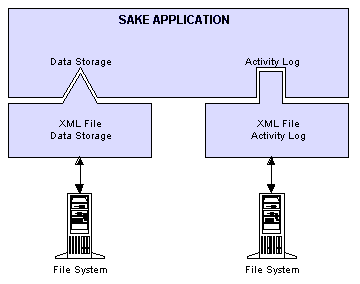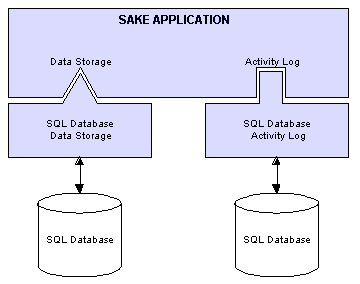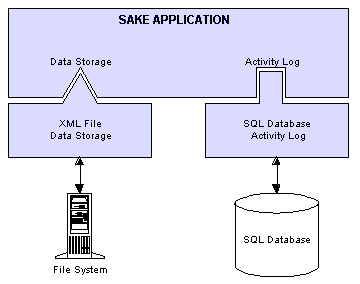|
Extending Saké
Structure
All of the actual operations that a Saké application performs
are implemented via JavaBeans modules that conform to standard
interfaces. Endymion generally provides these modules in several
different varieties, so that you can create a custom Saké installation
that suits your site. In many cases, customers choose to create
their own modules and plug them in to Saké in order to integrate
specific features into an existing framework.
As an example of how the Saké extension
mechanism works, take a look at Figure 1. In this illustration,
we have a Saké application that has some specific task. In performing
that task, the Saké application needs to perform two critical
operations, it needs to store and retrieve application data in
some persistent manner, and it needs to maintain a log of its
output. The default configuration of this Saké application uses
an "XML File" extension bean for each of these tasks,
meaning that the provided modules implement their tasks by reading
and writing XML files to the local file system.
 |
| Figure
1: A Saké application that uses XML file modules to
implement its tasks. |
In Figure 2, we see the exact same Saké application,
but this installation has been configured to use extension modules
that implement their tasks by connecting to SQL databases.
 |
| Figure
2: The same Saké application using SQL databases on
the back end. |
In Figure 3, we see the same application again, but
this time using one XML file module and one SQL database module.
Saké is intentionally designed to allow administrators to mix
and match back-end modules, so that they can create installations
with complete flexibility.
 |
| Figure
3: The same Saké application with modules that use different
back-end storage systems. |
Each Saké application needs to perform different tasks.
For example, Saké Mail has a module for storing user messages,
another module for implementing address book functionality, another
module for implementing user options storage, etc. For specific
details on configuring extension beans for your Saké application
installation, see the "Extending" section for your specific
Saké application.
If you are interested in developing custom
modules to replace certain existing Saké extension beans, contact
Endymion Corporation technical support at support@endymion.com
for information on accessing example source code and specific
assistance for your unique situation. Assistance with the extension
mechanism is included in our standard licensing agreements.
Example
As an example, there is only one type of extension bean that
is supported by every Saké application at the Saké framework level.
The "LogBean" interface specifies
the behavior that is necessary for a Saké application to produce
logs at runtime. The specification for a "LogBean"
is very simple, a "LogBean"
only needs to support two methods, "prepareLog()"
and "logEvent()".
Endymion provides one implementation
of the "LogBean" interface,
a bean called "TextFileLogBean".
You can invoke this bean from your "general.ini"
initialization file by adding
the following:
|
<extension-bean kind="Log" class="com.endymion.sake.servlet.beans.TextFileLogBean">
<!-- The file name of your log output. -->
<parameter type="String" name="FileName"
value="/var/log/sake.log" />
<!-- The level of detail of your output. -->
<parameter type="Int" name="LogDetailLevel"
value="3" />
<!-- Whether the log should append when the server
is
restarted, or be overwritten. -->
<parameter type="Boolean" name="Append"
value="true" />
</extension-bean>
|
The above example will create a log of
the application's output in the file "/var/log/sake.log".
As in the above example, extension beans are invoked by specifying
their Java class name in the configuration file for the Saké application
that they will operate under. The initialization file tag "extension-bean"
specifies the beginning of an extension bean invocation. The parameter
"kind" specifies exactly
what kind of bean you are specifying. Some varieties of bean must
be configured in order for the Saké application to run. For example,
Saké Mail cannot operate without a bean configured to implement
the "MessageStore" functionality.
Other types of beans are optional. For example, the above bean
is optional, without it the Saké application will simply write
log output to standard output, and no log file will be created.
Some extension beans can even be chained. An example of this is
also the above logging bean. You can create several log beans
in a single Saké application. For example, adding the following
to your "general.ini" initialization
file will result in your Saké application creating two different
logs at runtime, at two different levels of detail:
|
<extension-bean kind="Log" class="com.endymion.sake.servlet.beans.TextFileLogBean">
<!-- The file name of your log output. -->
<parameter type="String" name="Filename"
value="/var/log/sake.1.log" />
<!-- The level of detail of your output. -->
<parameter type="Int" name="LogDetailLevel"
value="3" />
<!-- Whether the log should append when the server
is
restarted, or be overwritten. -->
<parameter type="Boolean" name="Append"
value="true" />
</extension-bean>
<extension-bean kind="Log" class="com.endymion.sake.servlet.beans.TextFileLogBean">
<!-- The file name of your log output. -->
<parameter type="String" name="Filename"
value="/var/log/sake.3.log" />
<!-- The level of detail of your output. -->
<parameter type="Int" name="LogDetailLevel"
value="3" />
<!-- Whether the log should append when the server
is
restarted, or be overwritten. -->
<parameter type="Boolean" name="Append"
value="false" />
</extension-bean>
|
The above example will create two different logs at
runtime, "/var/log/sake.1.log",
which has a level of detail of 1, and "/var/log/sake.3.log",
which has a level of detail of 3. Since the second log will be
much more detailed and therefore much larger, it is configured
to be overwritten each time the application restarts.
TemplateSelectorBean
TemplateSelector beans can be used to determine a default template
set for a given browser. You can build your own TemplateSelector
bean, which will be invoked any time that a Saké application needs
to decide what "skin" to use for a new browser. You
can use this mechanism to provide a customized interface to Palm
VII users, WAP users, and different interfaces to different web
browsers and versions, for instance. You could also use the bean
to automatically provide different language
translations to users based on what URL they use to access
the installation.
|



